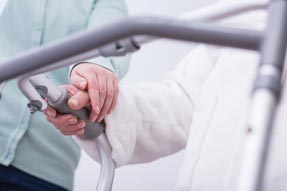10 tips for inpatient geriatric care
Optimizing inpatient geriatric care is a common priority for physicians, according to a speaker at the Society of Hospital Medicine's 2016 meeting, held in San Diego in March.
Optimizing inpatient geriatric care is a common priority for physicians, but Rosanne M. Leipzig MD, PhD, FACP, put the task more explicitly, titling her Hospital Medicine 2016 talk “Don't Kill Granny.”
She reminded attendees at the annual conference of the Society of Hospital Medicine, held in San Diego in March, about the dramatic negative consequences that hospitalization poses for geriatric patients.

“Thirty to 40% of these folks lose at least 1 [activity of daily living] at discharge compared to how they were doing 2 weeks before admission. These are not people who stroked, these are not people who had big fractures. These are people who came in with pneumonia, congestive heart failure, urinary sepsis—take your pick—and somehow that got better, but their function did not,” said Dr. Leipzig, who is a professor of geriatrics and palliative medicine at Mount Sinai School of Medicine in New York.
Once patients suffer this decline, they typically don't regain function and things get even worse, she noted, citing a study finding that patients who were more disabled at a month after discharge also had twice the risk of death within a year.
To try to remedy this situation, she offered a top 10 list of advice to improve care for elderly inpatients.
1. Know the patient's baseline function.
“It is not the function that they're at when they see you,” said Dr. Leipzig. “When their family says, ‘2 weeks ago they were riding the bus and going to Shakespeare class,’ and you go, ‘Yeah, right,’ it can be true.”
Hospitalists should ask patients, or their families, about function 2 weeks prior to the acute illness that led to hospitalization, to get an idea of whether a patient is back to or near baseline at discharge, she advised.
2. Only order bed rest “for dead people and a couple of others.”
It's particularly difficult for older patients to regain function after prolonged bed rest, Dr. Leipzig noted. “It ends up that people, once you put them on bed rest in the hospital, become deconditioned, fall, have a fracture, get delirious, malnourished, dehydrated, aspirate, have catheters inserted, get chemical and physical restraints, pressure sores, and infections,” she said.
Early ambulation improves patient outcomes, according to a systematic review published in Clinical Nurse Specialist in 2012. “The protocols that used a standardized and structured format had the best outcomes,” Dr. Leipzig said.
Explaining the importance of ambulation to patients can also be helpful, she noted, citing a 2011 study in Archives of Internal Medicine. “They gave the patients some education and had them self-reflect and come up with some goals to try and get them to be less likely to fall in the hospital,” she said. Goals included asking for help ambulating when needed, wearing safe footwear, and exercising to gain strength and balance, and in the study, having picked goals halved falls among cognitively intact patients.
Finally, physician orders can be improved through changes to electronic health record systems. “We had 9 orders for activity. Nobody knew what 5 of them even meant. We got down to 4. We made bed rest the last one, and you have to have an indication if you're going to do that, and it's made a real difference,” said Dr. Leipzig.
3. Get rid of the tethers.
Ambulation is easier and safer for patients if they're not tethered by IV lines or catheters, Dr. Leipzig noted. “People do not have to have an IV in place to be in the hospital. I hear this all the time. It's like an urban myth,” she said.
4. Think twice before you add a new medication, and remember the dose.
One of the main goals of Dr. Leipzig's advice was to reduce inpatient falls and delirium, and medications can have a significant impact on both. “Prescribe like Goldilocks—not too much, not too little, just right,” she said.
Physicians should know the fall-risk-increasing drugs (FRIDs) and delirium-risk-increasing drugs (DRIDs), which heavily overlap, Dr. Leipzig said. They include psychotropic drugs, opioids, first-generation antihistamines, skeletal muscle relaxants, anticonvulsants, and alcohol.
Drug-related falls are most likely to occur when new medications are introduced, when a patient is taking multiple FRIDs, or when a medication dose is increased, she noted. When choosing a dose, physicians should remember that they “get more bang for the buck,” that is, older patients have greater medication effects at lower doses than younger patients, Dr. Leipzig said.
5. Don't order a medication without knowing your patient's estimated glomerular filtration rate.
One reason for the larger effect of medication in older patients is that many have reduced renal function. Because older patients have less muscle and water in their bodies, creatinine levels will not necessarily reveal this. “Recognize that a normal creatinine is not the same as normal kidney function,” said Dr. Leipzig.
6. Think medication whenever there is a new symptom.
Because drugs can have so strong an effect on older patients, they should be the first suspect when a new symptom appears, especially those that have been recently approved, according to Dr. Leipzig. “We've got to be really careful about using new medications in older adults. You're not going to see these side effects in your Epocrates. It's 10 years after the drug's out when you see, ‘Oh, this can cause falls, this can cause cognitive impairment,’” she said.
7. Assess daily for delirium in hospitalized elders.
One of those new symptoms may be delirium. “If you can't prevent delirium, you need to identify and treat it early,” said Dr. Leipzig. “What's going to change more in an 80-year-old who is hospitalized, from day to day—their heart sounds or their mental status? Assess it daily.”
8. If you're told somebody has altered mental status or agitation, assume it is delirium until proven otherwise.
“We so often just accept wide variation in behavior,” said Dr. Leipzig. “The real question is, ‘Why are they agitated?’”
The cause of agitation might be delirium, but it could also be pain or even a visiting relative who has upset the patient, she noted. Physicians should try to figure out the cause and do whatever they can to avoid putting a patient in restraints or on antipsychotics. Potential alternative solutions include increasing nursing surveillance, modifying medications, providing hearing and vision aids, and involving family and friends.
The last of those works better than you might expect, Dr. Leipzig said. “I've had patients who've been totally delirious. I call their wives, put them on the phone—the wife orients the husband and they calm down.”
9. Restrict diet only when absolutely necessary.
Low-sodium diets should be prescribed only for patients with serious volume overload, Dr. Leipzig advised. “Old folks run dry,” she said. “The blood pressure will end up being much lower in the hospital than at home. ... and the hospital food is not so tasty even with salt.”
10. Pay attention to amount of food consumed. Consider supplements.
On a related note, she recommended that physicians keep a close eye on how much nutrition their patients are getting, and supplement when needed.
Finally, Dr. Leipzig offered a bonus tip about a tool she likes to use with geriatric patients: ePrognosis, a website from the University of California, San Francisco.
“This website has calculators for people who are in the hospital, people who are at home, people who are at the nursing home, people who are demented, to try and get an understanding of what their prognosis is, to help with the decisions that we make,” she said, noting that the calculator results can be useful in determining which interventions are worthwhile for patients. “Take a second and step back and think about prognostication and prioritization.”



